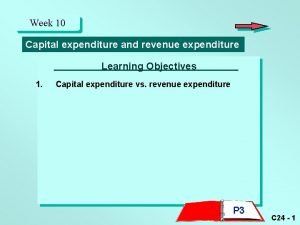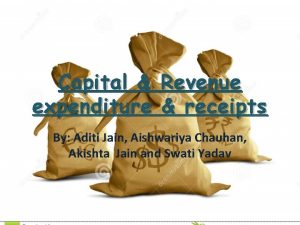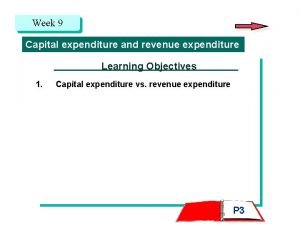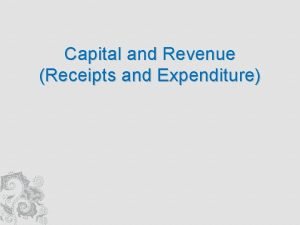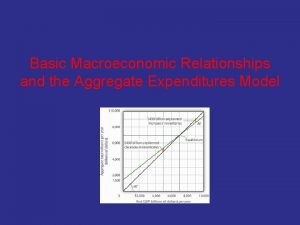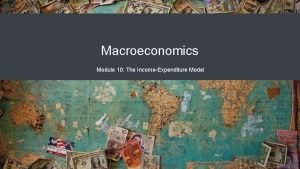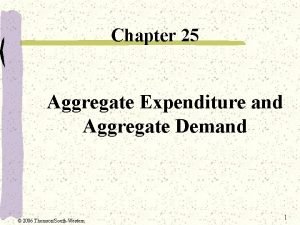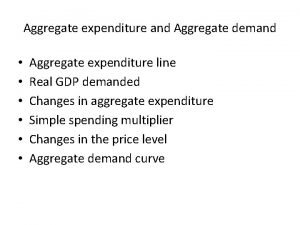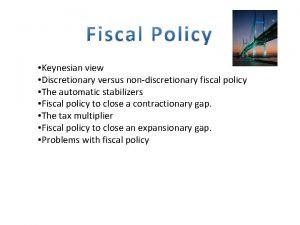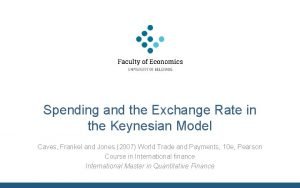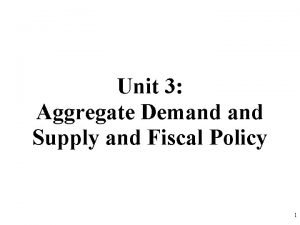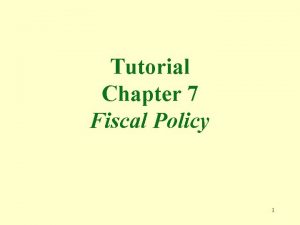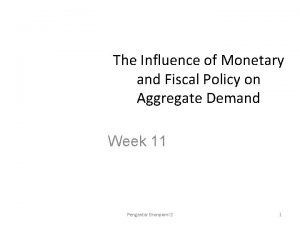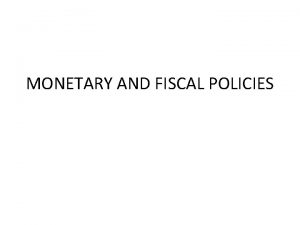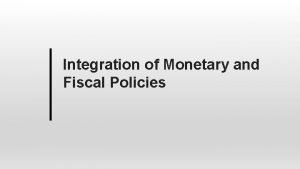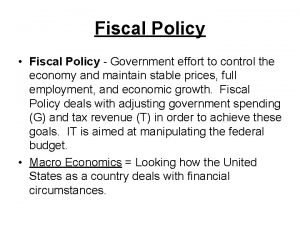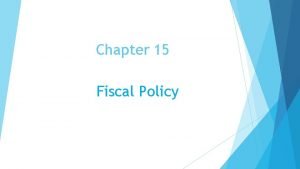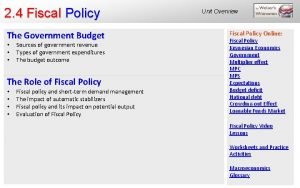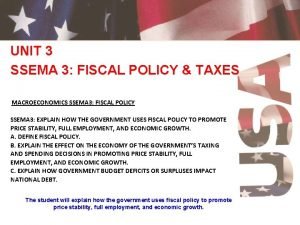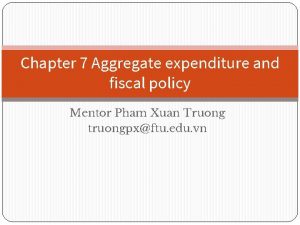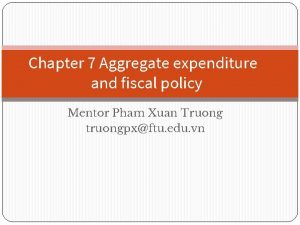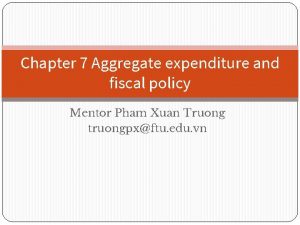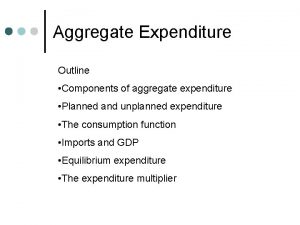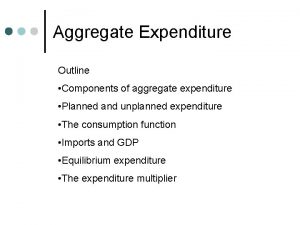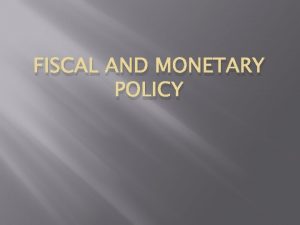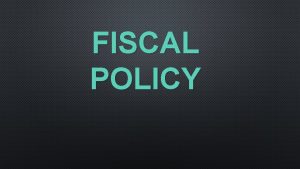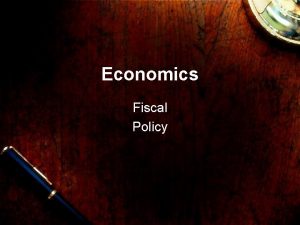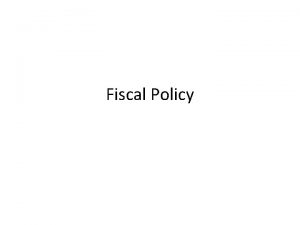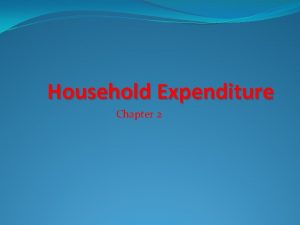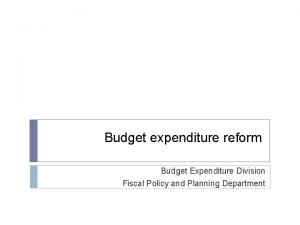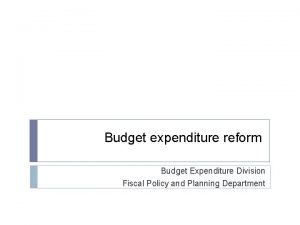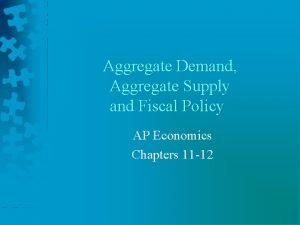Chapter 7 Aggregate expenditure and fiscal policy Mentor




































- Slides: 36

Chapter 7 Aggregate expenditure and fiscal policy Mentor Pham Xuan Truong truongpx@ftu. edu. vn

Content I Aggregate expenditure model (Keynesian cross point model) 1 Introduction to aggregate expenditure model 2 Mathematical form of aggregate expenditure model 3 Aggregate expenditure model and aggregate demand II Fiscal policy 1 What is fiscal policy 2 Effects of fiscal policy on the economy 3 Fiscal policy and government budget


Personal and marital life of Keynes �Born at 6 Harvey Road, Cambridge, John Maynard Keynes was the son of John Neville Keynes, an economics lecturer at Cambridge University, and Florence Ada Brown, a successful author and a social reformist. His younger brother Geoffrey Keynes (1887– 1982) was a surgeon and bibliophile and his younger sister Margaret (1890– 1974) married the Nobel-prizewinning physiologist Archibald Hill. Keynes was very tall at 1. 98 m (6 ft 6 in). �In 1918, Keynes met Lydia Lopokova, a well-known Russian ballerina, and they married in 1925. By most accounts, the marriage was a happy one. Before meeting Lopokova, Keynes's love interests had been men, including a relationship with the artist Duncan Grant and with the writer Lytton Strachey. For medical reasons, Keynes and Lopokova were unable to have

I Aggregate expenditure model (Keynesian cross point model) 1 Introduction to aggregate expenditure model Main idea The Great Depression caused many economists to question the validity of classical economic theory They believed they needed a new model to explain such a pervasive economic downturn and to suggest that government policies might ease some of the economic hardship that society was experiencing. In 1936, John Maynard Keynes wrote The General Theory of Employment, Interest and Money. In it, he proposed a new way to analyze the economy, which he presented as an alternative to the classical theory. Keynes proposed that low aggregate demand is responsible for the low income and high unemployment that characterize economic downturns. He criticized the notion that

I Aggregate expenditure model (Keynesian cross point model) 1 Introduction to aggregate expenditure model Main idea In the General Theory of Money, Interest and Employment, Keynes proposed that an economy’s total income was, in the short run, determined largely by the desire to spend by households, firms and the government (i. e. aggregate demand). The more people want to spend, the more goods and services firms can sell. The more firms can sell, the more output they will choose to produce and the more workers they will choose to hire. Thus, the problem during recessions and depressions, according to Keynes, was inadequate spending. The Keynesian cross is an attempt to

I Aggregate expenditure model (Keynesian cross point model) 1 Introduction to aggregate expenditure model Other assumptions + Prices, Wages and Interest Rate are Constant: this implies the rigidity of specific market due to objective reasons + The Economy Operates at less than full Employment: this implies that firms are willing to supply any amount of the good at a given price P. In other words, assume that the supply of goods is completely elastic at price P. This assumption is generally valid only in the short run

I Aggregate expenditure model (Keynesian cross point model) 1 Introduction to aggregate expenditure model Main idea illustrated by AD – AS model Price Level, P SRAS AD'' AD Y* Y*'' Income, Output, Y Compare to the idea of classical economists (2 special cases of AD – AS which imply behavior of the economy in (very) short run and long run)

I Aggregate expenditure model (Keynesian cross point model) 1 Introduction to aggregate expenditure model Building model The aggregate expenditure model which is illustrated by vertical axis of expenditure variable and horizontal axis of income (i. e. output) variable has two lines + Actual expenditure: is the amount households, firms , the government and foreigner spend on goods and services (GDP). + Planned expenditure (or APE – aggregate planned expenditure) is the amount households, firms, the government and the foreigner would like

I Aggregate expenditure model (Keynesian cross point model) 1 Introduction to aggregate expenditure model Building model Planned expenditure, APE Actual Expenditure, Y=APE Planned Expenditure, APE = C + I + G + NX Y 2 Y* Y 1 Income, Output, Y The economy is in equilibrium when: Actual Expenditure = Planned Expenditure (Y=APE) or total income = planned expenditure

I Aggregate expenditure model (Keynesian cross point model) 1 Introduction to aggregate expenditure model Building model + Actual expenditure is the 45 degree line, which implies the most important identity in the macroeconomics Total income = Total expenditure (this is also indicated by computing GDP in two ways but having the same result) + Planned expenditure has 3 properties * Upward sloping: expenditure is planned to increase as income increase * Positive intercept with vertical axis: when income is zero, the economy still plans to expenditure for necessaries. This level of expenditure is called autonomous expenditure (the lowest expenditure of the economy, the part of expenditure does not change as income rises) * Angular coefficient: has value between 0 and 1. It indicate normal behavior of economic entity. When you have

I Aggregate expenditure model (Keynesian cross point model) 1 Introduction to aggregate expenditure model Building model How does the economy get to this equilibrium? Inventories play an important role in the adjustment process. Whenever the economy is not in equilibrium, firms experience unplanned changes in inventories, and this induces them to change production levels. Changes in production in turn influence total income and expenditure, moving the economy toward equilibrium. + if actual expenditure > planned expenditure: unplanned inventory increases → firms decrease production + if actual expenditure < planned expenditure: unplanned inventory decreases → firms increase production

I Aggregate expenditure model (Keynesian cross point model) 1 Introduction to aggregate expenditure model Expenditure multiplier (by graph) Consider how changes in government purchases affect the economy. Because government purchases are one component of expenditure, higher government purchases result in higher planned expenditure, for any given level of income. An increase in government purchases of DG raises planned expenditure by that amount for any given level of income. The equilibrium moves from A to B and income rises. Note that the increase in income Y exceeds Planned expenditure, APE the increase in government purchases DG. Thus, fiscal Actual Expenditure, Y=APEpolicy in particular and total expenditure change in general has a multiplied B Planned Expenditure, effect on income. DG APE = C + I + G+ NX A DY Y* Y 1 Income, Output, Y

I Aggregate expenditure model (Keynesian cross point model) �

I Aggregate expenditure model (Keynesian cross point model) 1 Introduction to aggregate expenditure model Expenditure multiplier (by logical sequences) Spending in This Round Cumulative Total DI Round N. 1. Building bridge 1, 000 (DG) 1, 000 (DG 1) 2. Buying food 800, 000(DC 2=0. 8*DG) 1, 800, 000 3. Spending on education 640, 000(DC 3=0. 8*DC 2) 2, 440, 000 4. Spending on service 512, 000(DC 4=0. 8*DC 3) 2, 952, 000 5. Spending on clothes 409, 600(DC 5=0. 8*DC 4) 3, 361, 600 . . 50 . . . 18(DC 50=0. 8*DC 49) . . . “Infinity” 0 . . 4, 999, 929. . . . Assume that people save 20% and consume 80% of their additional income (0. 8 plays the role of b)

I Aggregate expenditure model (Keynesian cross point model) �

I Aggregate expenditure model (Keynesian cross point model) �

I Aggregate expenditure model (Keynesian cross point model) 2 Mathematical form of aggregate expenditure model + I - investment: in this model we will take investment as given or, in other words, we will regard it as an exogenous variable. The main reason for taking investment as given is to keep our model simple and follow the concept proposed by Keynes animal spirit. This concept implies current investment depends on expectation on future (e. g. future profit)rather than current income Y. Therefore

I Aggregate expenditure model (Keynesian cross point model) 2 Mathematical form of aggregate expenditure model + G – government spending: in this model, government spending also is given as an exogenous variable. The reason is that government spending depends on various factors such as social welfare, national security and of course economic situation. To a certain extent, we can consider government spending does not depend on current income Y

I Aggregate expenditure model (Keynesian cross point model) 2 Mathematical form of aggregate expenditure model + NX – net export (X – M): in this model, export also is given as an exogenous variable. The reason is understandable as export of a country does not depend on income of person in the country (however opposite way could be true). Import, on the other hand, is treated as endogenous variable due to import’s dependence on income where MPM is marginal propensity to import, which

I Aggregate expenditure model (Keynesian cross point model) �

I Aggregate expenditure model (Keynesian cross point model) �

I Aggregate expenditure model (Keynesian cross point model) �

Economy Tax Simple (no government no international trade) No tax Close (government) Expenditure multiplier Tax multiplier na Lump sum tax Proportional tax na Combined tax Open (government) Lump sum tax Proportional tax na Combined tax expenditure multiplier without tax is greater then with tax expenditure multiplier in close economy is greater than open economy

Math problems 1. Close economy with government has following data = 300 MPC = 0, 8 = 200 = 300 t = 0, 25 (25%) a Find consumption function of household, planned expenditure function of the economy, autonomous expenditure b Find output at equilibrium c If government spending increases by 200, find the new equilibrium output d If government would like to have output at 2500. Find the value of G

Math problems 2. Open economy with government has following data a Find consumption function of household, planned expenditure function of the economy, autonomous expenditure b Find output at equilibrium c If government spending increases by 20 and investment increases by 5, find the new equilibrium output d If government would like to have budget balance. Find the value of G

Math problems 3. Open economy with government has following data a Find consumption function of household, planned expenditure function of the economy, autonomous expenditure b Find output at equilibrium c If government spending increases by 100 and tax increases by 200, find the new equilibrium output d If government would like to have trade balance (NX = 0). Find the value of G

I Aggregate expenditure model (Keynesian cross point model) 3 Aggregate expenditure model and aggregate demand Change in price level will affect C, I, NX by wealth effect, interest rate effect and international trade effect (see aggregate demand curve)→ shift of planned expenditure curve → move along a AD curve

I Aggregate expenditure model (Keynesian cross point model) 3 Aggregate expenditure model and aggregate demand Change in other factors not price level → shift of planned expenditure curve → shift of AD curve +) APE shifts upward (C, I, G, NX increase not by Y) = AD shifts rightward +) APE shifts downward (C, I, G, NX increase not by Y) = AD shift leftward

II Fiscal policy 1 What is fiscal policy Fiscal policy is the policy of government to use taxation and government spending to regulate aggregate demand There are two types of fiscal policy + Expansionary fiscal policy: government raises spending or/and reduces tax + Contractionary fiscal policy: government reduces spending or/and raises tax In economy, there is mechanism to automatically change government spending and taxation in accordance with the situation of the economy. It is called as automatic stabilizer. Two pillars of automatic stabilizer are unemployment subsidy and income tax system

II Fiscal policy 2 Effects of fiscal policy on the economy Expansionary fiscal policy A E P SRA S APE’ APE AD’ Y AD Y Effects: output increases (unemployment rate decreases), price level rises (inflation rate increases) Apply: when economy is in crisis, output declines and unemployment rises

II Fiscal policy 2 Effects of fiscal policy on the economy Contractionary fiscal policy A E P Short run AS APE’ AD Y AD’ Y Effects: output decreases (unemployment rate increases), price level declines (inflation rate decreases) Apply: when economy is in boom, output sharply increases and inflation rate rises

II Fiscal policy 2 Effects of fiscal policy on the economy Automatic stabilizer When economy is in crisis, government spending increases and tax collection decreases automatically (government has to pay more for unemployment subsidy automatically by labor law and incurs automatic reduction in income tax collection by income tax law) = expansionary fiscal policy When economy is in boom, government spending decreases and tax collection increases automatically (government has to pay less for unemployment subsidy automatically by labor law and enjoys automatic increase in income tax collection by income tax law) = contractionary fiscal policy

II Fiscal policy 3 Fiscal policy and government budget Government budget total sum of revenues and consumption of government in given time (one year) BB= T – G + BB= 0: Budget balance + BB> 0: Budget surplus + BB < 0: Budget deficit Fiscal policy can reach following objectives + Budget balance but Y can fluctuate (budget prioritized fiscal policy) + Potential output Y* but budget deficit can happen seriously (in time of crisis) (output prioritized fiscal policy)

II Fiscal policy 3 Fiscal policy and government budget How to reduce budget deficit - Increasing tax revenues and decreasing government spending - Issuing Government bond - Borrowings from foreign countries or international organizations - Printing money or using reserve from foreign currency

Key concepts - Aggregate planned expenditure - Keynesian cross point model - Consumption function - Autonomous consumption, autonomous - expenditure Proportional tax, lump sum tax, combined tax Endogenous variable, exogenous variable Expenditure multiplier, multiplied effect Marginal propensity to consume, marginal propensity to import Expansionary fiscal policy, contractionary fiscal policy
 Unit 3 aggregate demand aggregate supply and fiscal policy
Unit 3 aggregate demand aggregate supply and fiscal policy Tax multiplier formula
Tax multiplier formula Unit 3 aggregate demand aggregate supply and fiscal policy
Unit 3 aggregate demand aggregate supply and fiscal policy Capital and revenue expenditure
Capital and revenue expenditure Capital expenditure and revenue expenditure examples
Capital expenditure and revenue expenditure examples What is capital and revenue expenditure
What is capital and revenue expenditure Capital expenditure vs revenue expenditure
Capital expenditure vs revenue expenditure Shift in sras curve
Shift in sras curve Aggregate expenditure and equilibrium output
Aggregate expenditure and equilibrium output Calculate aggregate expenditure
Calculate aggregate expenditure Aggregate expenditure model
Aggregate expenditure model Aggregate expenditure model
Aggregate expenditure model Aggregate expenditure model
Aggregate expenditure model Aggregate line
Aggregate line Ad curve graph
Ad curve graph Tableau cannot mix aggregate and non aggregate
Tableau cannot mix aggregate and non aggregate Lesson 2 activity 45 macroeconomics
Lesson 2 activity 45 macroeconomics Discretionary and non discretionary fiscal policy
Discretionary and non discretionary fiscal policy Expenditure dampening policy diagram
Expenditure dampening policy diagram Fiscal policy to control inflation
Fiscal policy to control inflation Example fiscal policy
Example fiscal policy Fiscal policy practice
Fiscal policy practice Components of fiscal policy
Components of fiscal policy Crowding out effect of fiscal policy
Crowding out effect of fiscal policy What is liquidity ratio in banking
What is liquidity ratio in banking Instruments of fiscal policy
Instruments of fiscal policy Fiscal policy ib economics
Fiscal policy ib economics Fiscal demand side policy
Fiscal demand side policy Fiscal policy definition
Fiscal policy definition Types of fiscal policy
Types of fiscal policy Instruments of fiscal policy
Instruments of fiscal policy Crowding out
Crowding out Demand side fiscal policy definition
Demand side fiscal policy definition Contractionary fiscal policy interest rate
Contractionary fiscal policy interest rate Crowding out effect of fiscal policy
Crowding out effect of fiscal policy Example of expansionary fiscal policy
Example of expansionary fiscal policy Iousa worksheet
Iousa worksheet



